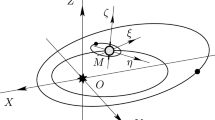Abstract
There is a large set of papers and monographs which consider the restricted three-body problem and apply the results to the orbits of satellites or spacecrafts in the Earth–Moon system. These studies ignore the impact of the Sun on these orbits. This approximation is justified for satellites in close Earth orbit. However, for satellites whose orbit is around the Sun, the Earth and the Moon or one of the Lagrange points the impact of the Sun’s presence cannot be ignored and one has to consider a four-body problem. In this paper, we derive the general equations of motion for satellites in a system that consists of a central body (Sun), first and second primaries and a satellite. These equations can be used for mission planning in general. Obvious practical example of such a system consists of the Earth and the Moon as the first and second primaries. These equations are then used in this paper to illustrate the impact of the central body on the motion of satellites around the two primaries.









Similar content being viewed by others
Data Availability
All MATLAB programs that were used to derive the numerical results of this paper are available upon request from the author. The only data used in this paper are in the public domain (see reference Szebehely (1967)).
References
Arenstorf, R.F.: Periodic solutions of the restricted three body problem representing analytic continuations of keplerian elliptic motions. Am. J. Math. 85(1), 27–35 (1963)
Boudad, K. K.: Trajectory Design Between Cislunar Space and Sun–Earth Libration Points in a Four-Body Model, Ph.D dissertation, Perdue University, 2022
Bruno, A.D.: The Restricted 3-body Problem: Plane Periodic Orbits. Walter de Gruyter, Berlin (1994)
Casoliva, J., Mease, K., Mondelo, J., Villac, B., Barrabes, E., Olle, M.: Families of Cycler Trajectories in the Earth-Moon System. AIAA/AAS Astrodynamics Specialist Conference, Honolulu, Hawaii, August 18-21, (2008)
Condurache, D., Martinusi, V.:Relative spacecraft motion in a central force field. J. Guidance Control Dyn. 30 (3) (2007)
Condurache, D.: A novel method for higher-order kinematics in multibody systems, 73rd International Astronautical Congress (IAC), Paris, France, September 18–22, 2022
Gao, F.B., Zhang, W.: A study on periodic solutions for the circular restricted three-body problem. Astron. J. 148, 116 (2014)
Henon, M.: Generating Families in the Restricted Three-Body Problem. Springer, New-York (1997)
Humi, M.: Approximate equations for the coplanar restricted three body problem in 3-dimensions. AIAA J. Guidance Control 25, 182–184 (2002)
Humi, M.: The planar three body problem in rendezvous coordinates. AIAA J Guidance Control Dyn. 28, 553–557 (2005)
Humi, M.: The Restricted Three Body Problem with Quadratic Drag. Electron. J. Theor. Phys. 6(22), 203–218 (2009)
Humi, M., Carter, T.: Forced Keplerian orbits in the Earth-Moon system. Acta Astronaut. 193, 538–550 (2022)
Jacobi, C.G.: CR Acad. Sci. Paris 3, 50 (1834)
Kolemen, E., Kasdin, N.J., Gurfil, P.: Multiple Poincare Sections Method for Finding the Quasiperiodic Orbits of the Restricted Three Body Problem. Celest. Mech. Dyn. Astron. 112(1), 47–74 (2012)
Koon, W.S., Lo, M.W., Marsden, J.E., Ross, S.D.: Dynamical Systems, the Three-Body Problem and Space Mission Design. Marsden Books, Wellington (2011)
Levi-Civita, T.: Sur la regularisatio du probleme des trois corps. Acta Math. 42, 99–144 (1920)
Mingotti, G., Topputo, F., Bernelli-Zazzera, F.: Low-energy, low-thrust transfers to the Moon. Celest. Mech. Dyn. Astron. 105, 61–74 (2009). https://doi.org/10.1007/s10569-009-9220-7
Moon Fact sheet https://nssdc.gsfc.nasa.gov/planetary/factsheet/moonfact.html
Moon Fact sheet https://nssdc.gsfc.nasa.gov/planetary/factsheet/moonfact.html
Moulton, FR.: An Introduction to Celestial Mechanics, (Chapter 8), Dover Publications, NY, (1970)
Musielak, Z.E., Quarles, B.: The three-body problem. Rep. Prog. Phys. 77, 065901 (2014)
Nie, T., Gurfil, P.: Lunar frozen orbits revisited. Celest. Mech. Dyn. Astron. 130(61), 1–35 (2018)
Poincare, H.: New Methods of Celestial Mechanics, Chapter \(6\). Springer, New York (1992)
Szebehely, V.: Theory of Orbits. The Restricted Problem of Three Bodies. Academic Press, New York (1967)
Zaborsky, S.: Generating Solutions for Periodic Orbits in the Circular Restricted Three-Body Problem. J. Astronaut. Sci. 67, 1300–1319 (2020). https://doi.org/10.1007/s40295-020-00222-3
Acknowledgements
The author is indebted to the anonymous referee of one of his previous papers who suggested the topic addressed in this paper.
Author information
Authors and Affiliations
Contributions
All contributions are provided by the author Mayer Humi.
Corresponding author
Ethics declarations
Conflict of interest
The authors declare that they have no known conflicting financial interests or personal relationships that could have appeared to influence the work reported in this paper.
Additional information
Publisher's Note
Springer Nature remains neutral with regard to jurisdictional claims in published maps and institutional affiliations.
Rights and permissions
Springer Nature or its licensor (e.g. a society or other partner) holds exclusive rights to this article under a publishing agreement with the author(s) or other rightsholder(s); author self-archiving of the accepted manuscript version of this article is solely governed by the terms of such publishing agreement and applicable law.
About this article
Cite this article
Humi, M. Satellites’ orbits in the Sun–Earth–Moon system. Celest Mech Dyn Astron 135, 30 (2023). https://doi.org/10.1007/s10569-023-10146-3
Received:
Revised:
Accepted:
Published:
DOI: https://doi.org/10.1007/s10569-023-10146-3




